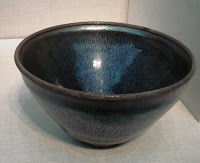 Claude Presset, a Swiss ceramist and teacher has curated an exhibition of cups by a hundred different ceramists which is currently on display in Delhi. Each ceramist has created a series of ten cups each in which none of the cups are identical although each series has been created using only one technique.
Claude Presset, a Swiss ceramist and teacher has curated an exhibition of cups by a hundred different ceramists which is currently on display in Delhi. Each ceramist has created a series of ten cups each in which none of the cups are identical although each series has been created using only one technique.Each cup is approximately the same size as a kulhar : the traditional Indian teacup which was once commonly used but is now rarely seen -- the handcrafted, earthenware cup of yesteryear having now been replaced by mass produced cups often not even made of clay. And yet, the basic shape, structure and purpose of the cup has probably not significantly changed through the millennia. And so, as the exhibits -- displayed in packing cases -- demonstrate, the lines which demarcate 'tradition' from 'living tradition', and 'experimentation' from 're-interpretation' are in fact often amazingly thin.
At the end of the day, there is only so much that can be done to a cup to make it different from its predecessors, and this inability to innovate beyond a point means that the cups which are in use today are essentially the same cups which were in use from the time when men first learnt to fire clay to create not just utensils for daily use but art in terracotta, pottery, and, finally, porcelain. And, if one were to think of it, what that also means is in each cup lies much history.
Countries such as Japan have elaborate rituals associated with tea, and although not all countries have such rituals, it would be hard to argue that the humble cup is not, in some way, a repository of culture.
Image: PericlesofAthens